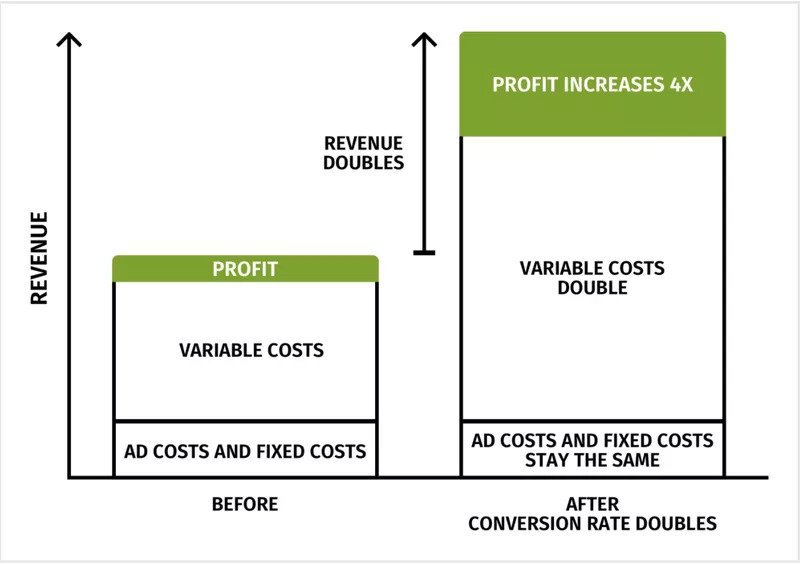
Are you worried about the number of visitors on your website that are converting into real customers? Are you concerned about increasing your revenue in the most cost-effective, scientifically proven, and direct way?
Good news - you are not the only one out there.
Studies show that the average conversion rate of e-commerce websites is 2.86% in the US and 4.31% globally.
Businesses are now emphasizing Conversion Rate Optimization more than ever. Marketers today are focused on improving the quality of traffic, rather than quantity.
Conversion Rate Optimization research, if done right, creates a strong foundation for your CRO strategy, and the right CRO tool can help you understand why your visitors aren't converting into leads or customers.
This article discusses what Conversion Rate Optimization is, and offers tips on what you should do while conducting CRO research.
The systematic process of raising the percentage of website visitors who perform the desired action - whether it's filling out a form, making a purchase, engaging with online chat, registering on the site - or otherwise - is known as conversion rate optimization, or in short, CRO.
Understanding how visitors scroll across your site, what actions they take, and what's blocking them from fulfilling your goals are all part of the conversion rate optimization process.
In simple terms, your conversion rate is the percentage of customers who do what you want them to do.
Calculating conversion is pretty straightforward. All you need to do is divide the number of conversions you receive in a given period by the total number of visitors who visited your site or landing page and then multiply it by 100.

For Example, if your website had 18,232 visitors and had 2032 conversions this month, your conversion rate would be,
(2032/18232) x 100 = 11.14%.
A healthy conversion rate indicates that your website, app, or product is targeting the proper audience, running smoothly, and providing a great experience to the users.
Conversion rate optimization includes assisting visitors to your store in finding what they're looking for and streamlining the purchase process.
The better you know your clients, the better you can customize their experience and encourage them to make all those important transactions.
When it comes to Conversion Rate Optimization, efficiency is also a major factor.
If your primary goal is to attract visitors to your site, CRO should be a key focus to ensure that more of that traffic converts into potential and paying customers. The better the customer experience, the more customers you'll attract from the same quantity of traffic, resulting in satisfied customers and lower acquisition costs (CPA).
When your conversion rate increases, your overall costs do not rise. Your fixed costs and advertising costs remain the same.
As your conversion rate increases, your variable cost such as the cost of extra units and the cost of extra distribution will increase. Your revenue will also rise simultaneously, thanks to the increase in paying customers.

CRO and SEO aren’t mutually exclusive practices, rather they are closely associated. Search is becoming smarter, and Google has confirmed that user behavior is now factored into page rankings.
Websites that provide the smoothest user experience will rank higher. So all of your efforts to improve the customer journey will result in not only more conversions but also lead to more revenue.
Like it or not, an increasing number of online businesses are competing for your clients. Some of them (for example, Amazon) are just taking down smaller retailers.
If you want to convert your page visitors into customers, you'll need a website that is user-friendly and automatically directs them to the tasks you want them to perform. You must be more competitive as the number of your competitors increase.
Conversion optimization has the advantage of helping you to stay ahead of the competition.
Conversion Rate Optimization will help you to create personalized customer experiences for both new and returning users to your website thus increasing your customer retention.
By using Conversion rate optimization, you can segment your regular customers and show your appreciation with ‘welcome back' popups, targeted product recommendations in their most-purchased product categories, and repurchase reminder emails.
Conversion rate optimization has a lot of advantages. By anticipating the needs and making your customers feel unique, you can turn one-time buyers into loyal customers.
By concentrating on CRO, you can also obtain a better understanding of your customers, convert more visitors into customers, lower your Cost per Acquisition, improve your SEO efforts, and raise your customer lifetime value.
If your website is getting enough traffic but users are bouncing or not converting into customers, it's time to pay attention to conversion rate optimization (CRO).
Before you dive into it, you need to do your homework. CRO research is a key step that you should be paying attention to.
Here is a list of things you need to do during your Conversion Rate Optimization Research.
Conversion rate optimization (CRO) tools collect information about your website and its visitors to assist you to have a better understanding of how people use your site.
Conversion rate optimization (CRO) tools will also help you to:
Conversion Rate Optimization tools such as Proof Leads will not only save your time and money but will also provide you with relevant customer activity data that can help you improve your overall CRO strategy.
A/B testing compares two versions of a web page or app to see which performs better. It’s a type of experiment in which two or more variants of a page are shown to users at random. Then, a statistical analysis is performed to see which one works better for a certain conversion goal.
Experimentation is the most effective technique to reduce risk in decision-making while allowing your creative teams to explore new possibilities.
For example, If you're uncertain between two headline options for your page, you may run an A/B split test to see which one performs better. You make two separate versions of your page (X and Y), each with a different headline. A/B testing software will send half of the traffic to page X and the other half to page Y. Both pages feature a call to action, and at the end of the process, you count how many people responded.
The page with the most conversions clearly works best with your audience.
Your landing page must follow up when someone visits your website after reading your meta description on Google or seeing your search engine ad.
You must follow through on the promises made in your descriptions. For example, if a user clicks an ad after reading descriptions about summer outfits, they are going to expect to find Hawaiian shirts and swim trunks.
If they clicked through and the page only had pictures of kitchen wares, they would be confused.
If a landing page fails to deliver on what a user expected, they will not convert. That's why you should consider the full process, from viewing an ad to viewing your landing page to downloading an offer.
If your visitors aren’t converting, you might want to reassess your search engine descriptions and social media activity to check if your marketing communication channels are coordinated.
You should also focus on making it as simple as possible for users to do business with you.
Your customers should not have to figure out how to make a purchase or where to click to do so. It must be clear and straightforward. There should be as few clicks as necessary.
Shopping cart abandonment and conversion rate reductions on the checkout page may appear to be an unavoidable part of doing business online to many website owners. But it doesn't have to be like this, though.
In fact, by assisting your customer in making an informed, confident decision, you can reduce cart abandonment and improve conversion rates by a big margin.
Make sure your customer can understand everything on your checkout form, including CVV and input forms.
When a user types a credit card number, you can also automatically format it as they go along to make it simpler to read and less likely to be messed up.
Furthermore, the next transaction will be less "difficult" if you store your customers' card information so that they can make purchases without having to enter their card information each time. Your customers will be more likely to be satisfied with their purchases and return.
A call to action is a crucial component of every website, without which the firm and the customer would lose connection. To ensure that the customer identifies the need for the product being sold, the company must display eye-catching and informative CTAs that follow the basic rules of CRO optimization.
The Call-to-action should be created in such a way that customers feel obligated to take advantage of the offer.
Using the Proof Leads CTA and pop-up generation combo will make it simple to collect excellent leads from your website visitors without being intrusive or interrupting their browsing experience.
If you’re running a retail e-commerce store, make sure your products are clearly displayed. One of the major caveats of online shopping is that customers have to rely on images and videos to assess the product.
You can display your product using high-quality images and videos that will help the customers get an accurate idea of what the product looks like. This will help build trust with your customers as they will perceive your business as reliable.
A value proposition is a promise and value that you make to your customers by outlining the problem you solve and explaining why you're better than the competition.
A great value proposition appeals to the customer's most important decision factors. A convincing value proposition should explain to your consumers what makes you special, what sets you apart, and how you address challenges for your target demographic.
One of the most significant actions that marketers can benefit from when conducting conversion optimization research for their website is identifying the proper value proposition and translating it on their website.
Your value proposition should be one-of-a-kind so that you can stand out and be noticed among the rest.
If a user comes to your site and decides to return later, the chances of that visitor converting into a real customer will drop dramatically.
To avoid abandoned carts and failed conversions, use countdowns or phrases like "limited time" or "only a few available in stock" on your website.
When was the last time you went online to buy something?
Did you look for reviews before making a purchase?
Chances are that you’re one of the 90% of buyers who read online reviews while deciding on a product’s purchase.
Keeping a feedback mechanism that allows the customers to provide both positive and negative reviews of your products is essential if you’re looking to build trust with them.
Don’t suppress legitimate negative reviews under any circumstances. Instead, reach out to the customers who post complaints, and offer to fix the issues.
Build a customer satisfaction survey or a poll so that customers can provide feedback about their experience with your business. It will demonstrate that you are committed to listen to them and provide more of what they desire.
Make sure to include the review on the product pages so that visitors don't have to leave the product page to go to external review sites, where they can become distracted and may not return.
It is crucial to conduct your CRO research properly and use the right conversion rate optimization tools if you want to achieve a high conversion rate on your website.
CRO tools such as Proof Leads take advantage of visitors' innate desire to be a part of something bigger and better by showing them social proof notifications. This not only allows customers to appreciate your services and products but also leaves a long-lasting effect on them.
What are you waiting for? Sign up for a free trial today and sky-rocket your conversion rates in no time!